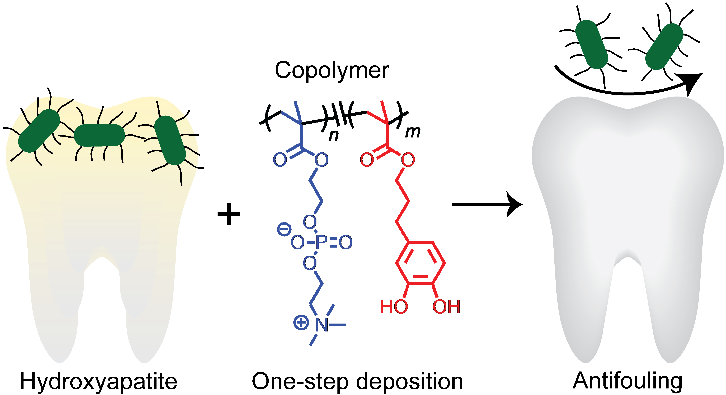Keeping Dental Bacteria Away using Sticky yet Slippery Copolymers
Work done in the lab of Prof. Todd Emrick & Prof. Jessica Schiffman at University of Massachusetts Amherst
Ashlin Sathyan is a Senior Scientist at DuPont HealthCare R&D Team at Midland, MI. Ashlin obtained her Ph.D. in Polymer Science and Engineering from University of Massachusetts Amherst in 2021 where she conducted research under the guidance of Prof. Todd Emrick. Ashlin’s doctoral work focused on the development of functional copolymers for material chemistry and interfaces, particularly polyamides and polyzwitterions. Prior to her Ph.D., Ashlin completed an integrated B.S. and M.S. in Chemical Sciences at the Indian Institute of Science Education and Research in Kolkata, India, under the supervision of Prof. Raja Shunmugham. Her research during that time involved studying the influence of chain length on homopolymer amphiphilicity. In her current role at DuPont, Ashlin is responsible for identifying, assessing, and developing new scientific concepts and technologies to address global challenges. Ashlin also manages scientific and technological projects, coordinates with cross-functional teams, and communicates research findings effectively to technical teams, management, and customers. Outside of her work she dedicates her time as an enthusiastic volunteer, lending her skills and passion to various organizations in the area. In addition, she actively engages with diverse scientific communities, fostering connections and collaborations with fellow researchers, scientists, and professionals.

Author Interview
How would you explain your research outcomes to the non-scientific community?
We as a group of polymer scientists and chemical engineers were puzzled how we can improve our oral health using a combination of material chemistry and chemical engineering tools. We developed polymers that contain sticky catechol units and slippery zwitterion functional groups. Once the ideal polymer composition was identified, we explored various testing parameters to identify the perfect coating specifications. We tested our polymers on multiple platforms but eventually focused on hydroxyapatite as a mimic to our teeth. We investigated how varying the composition of catechol and zwitterions impacted the adhesive and antifouling properties. Our polymers reduced the level of attachment of both Gram-negative Escherichia coli and Gram-positive Streptococcus oralis (which is an oral bacteria). Additionally, we explored in vitro experiments that mimicked the complex mouth environment (i.e., swallowing and using mouthwash) to evaluate S. oralis adhesion, finding that the copolymer coatings reduced the quantity of adhered bacteria. The findings from this work can be used to develop coatings as a protective layer that prevents the growth of bacteria and eventually restricts tooth decay and other oral health problems.

“By creating these antifouling coatings, we provide a new approach of preventing bacterial growth and maintaining oral hygiene.”
How do these findings contribute to your research area?
Our findings make a significant contribution to the field of oral health and material science. By creating these antifouling coatings, we provide a new approach of preventing bacterial growth and maintaining oral hygiene. This research opens up possibilities for developing improved oral care products that can better protect teeth. Our work also contributes to the broader field of biomaterials, showcasing the potential of advanced coatings for various applications beyond oral health.
What was the exciting moment during your research?
One of the most exciting moments was when we observed the effectiveness of our coatings in preventing bacterial adhesion. Seeing how the coatings repelled bacteria and reduced their presence on dental and oral surfaces was truly remarkable. This discovery sparked excitement among our team, as it confirmed the potential impact of our work in improving oral health and developing novel strategies for combating dental biofilms.
What do you hope to do next?
This work was part of the doctoral dissertation. I hope my former research groups will be exploring the practical implementation of these coatings in real-world applications. Hopefully, collaborating with industry partners to further develop and optimize the coatings can put this project on track for commercial use. Ultimately, I hope to see these coatings integrated into oral care products that can benefit people worldwide.
Where do you seek scientific inspiration from?
Nature itself serves as a remarkable source of inspiration to me, with its intricate biological systems and fascinating properties. It inspires me to uncover new solutions using my material science background. Talking to colleagues also helps me to gain inspiration that leads to exploring new ideas and approaches. Additionally, attending conferences and seminars allows me to learn from renowned scientists and gain exposure to cutting-edge research.
How do you intend to help Indian science improve?
My passion for research sparkled during my time at IISER, during my BS-MS days. I am always grateful for the opportunity to be trained as a material scientist by nation renowned scientists from IISER Kolkata. I believe that by mentoring and encouraging young scientists in India, we can nurture a vibrant scientific community. I offer mentorship to students, guiding them, sharing my experiences, and providing career advice. Additionally, I hope to continue engaging in science outreach activities to create awareness and foster interest in science among the broader public. One thing I have consistently been doing is conducting lectures at my high school alma mater, Catholicate Higher Secondary School, to encourage young minds to develop an interest in science and raise awareness about institutes such as IISER.
Reference: Sathyan, Ashlin, et al. “Using Catechol and Zwitterion-Functionalized Copolymers to Prevent Dental Bacterial Adhesion.” ACS Applied Bio Materials (2023).
Edited by: Pragya Gupta
Biopatrika: Bringing Science to Society
© Biopatrika 2023 All Rights Reserved.